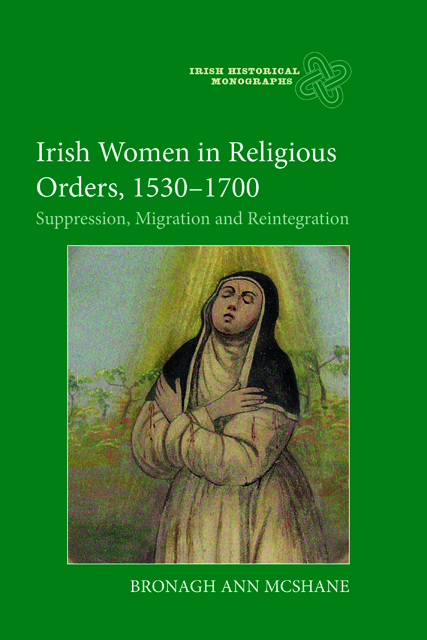2 - Negotiating religious change: survival and continuity in post-dissolution Ireland
Published online by Cambridge University Press: 17 December 2022
Summary
This chapter considers the experiences of displaced female religious in Ireland following the Henrician suppression campaigns (1537–43). It examines the ways in which they negotiated their survival in the post-dissolution period, and analyses their experiences within broader English and European contexts. The focus then shifts to exploring strategies utilised by women to negotiate the various challenges associated with the pursuit of religious lifestyles in Ireland in the medium to long-term aftermath of the Henrician dissolutions. Fleeting references in contemporary records to groups of women living under ‘simple’ religious vows and to individuals who observed religious lifestyles within the confines of their family homes, suggest that, despite the closure of the monasteries, religious vocation options for women were not wholly eradicated. Rather they continued – albeit in less formal, structured, and visible ways – throughout the late Tudor and early Stuart period. As was the case for their English and European counterparts, the patronage and protection afforded them by members of the laity proved vital to their survival. The experiences of these individuals and groups of women are examined against the backdrop of decades of sporadic political conflict and religious coercion in Ireland down to the end of the Tudor era and into the early decades of the seventeenth century.
As in England and Europe, the options for displaced female religious in Ireland were limited. Unlike their male counterparts, many of whom were appointed to positions within the hierarchy of the Tudor state church, women religious were left with no alternative for a formal religious vocation. Scholars such as Claire Cross, Mary Erler, Marilyn Oliva, and Noreen Vickers have adumbrated the various options pursued by English women religious in the wake of the closures; they either returned to live with family members (if their relatives were wealthy enough and willing to support them) where some continued to live out their religious vocations secretly; or they lived communally on former monastic premises and developed what Claire Cross has described as ‘pseudo-monastic’ communities. Migration to the Continent was another option, although one that was available only to those who possessed the requisite financial means to travel.
- Type
- Chapter
- Information
- Irish Women in Religious Orders, 1530-1700Suppression, Migration and Reintegration, pp. 61 - 92Publisher: Boydell & BrewerPrint publication year: 2022



